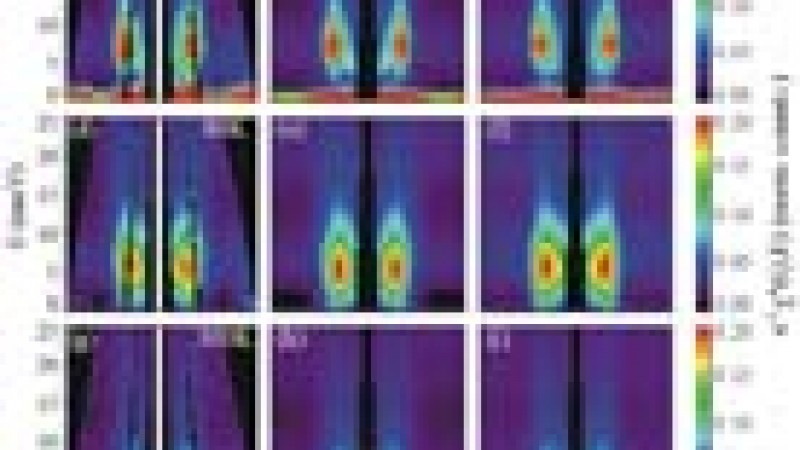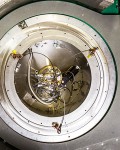Researchers have long thought that magnetism and superconductivity are mutually exclusive. The former typically involves localized atomic electrons. The latter requires freely propagating, itinerant electrons. That magnetism and high-temperature superconductivity (HTSC) are mutually exclusive was challenged by the recent discovery of antiferromagnetic phases in parent materials of both HTSC cuprates and iron pnictides and chalcogenides.
Antiferromagnetism is a form of magnetic ordering in which the spins of the outermost electrons localized on neighboring atoms preferentially align in opposite directions. Now, this magnetism is believed to give the necessary boost to the superconductivity in HTSC. Highly energetic spin fluctuations, discovered in these materials by inelastic neutron scattering, are further opening the field and are strong contenders for explaining the electron pairing in HTSC. Just how they do it, remains a fundamental mystery.
But from neutron scattering, a novel and unusual picture of magnetism has emerged in which localized atomic magnetism in the parent material of an iron-based superconductor is seen to get a boost from the itinerant conduction electrons in the lattice of the material, which increases the strength of magnetic fluctuations with increasing temperature. These discoveries challenge scientists’ current understanding of both superconductivity and magnetism.
A research team from Brookhaven National Laboratory and Oak Ridge National Laboratory recently used ARCS, the time-of-flight (TOF) Wide Angular-Range Chopper Spectrometer at SNS, to investigate magnetic fluctuations in iron telluride, parent to a superconductor family, with antiferromagnetic order. The researchers’ goal was to distinguish between models of magnetism in which the magnetic moments are mostly the result of localized or mobile (itinerant) electrons.
Ultimately, the work would be important for developing applications of high-temperature superconductors. The insights gained are also important for functional magnetic iron group alloys and for layered sensing systems, where magneto-transport is important.
What the researchers found was the opposite of the expected behavior, explained physicist Igor Zaliznyak of Brookhaven. “Usually, magnetism fades on heating, as nonmagnetic states become thermally populated. This effect (increasing magnetic strength with temperature) has not been anticipated by any theoretical work.”
“Contrary to the preexisting view that magnetism and superconductivity are mutually exclusive, magnetism appears to aid the HTSC,” Zaliznyak said. Up to now, the nature of this assistance, and even the nature of magnetic fluctuations―localized or itinerant―has been unclear and controversial.
Using inelastic neutron scattering at ARCS, the researchers found that the spins of localized and itinerant electrons existing in iron telluride are actually entangled at a fundamental level.
The real-space structure of the magnetic fluctuations is inconsistent with a purely itinerant electron picture,” said Zaliznyak. “But it can be explained by a simple model of local spin plaquettes that emerge.” But the magnetic spectral weight, achieved by measuring the magnetic fluctuations, showed them that the spin in such a model actually increases with increasing temperature, requiring roughly two localized electrons per atom of iron at temperatures at 10 K (-263.15°C) but nearly three such electrons at room temperature.
“This work addresses issues that are so basic to our understanding of the electronic transport and superconductivity that it would be difficult to imagine that it has no impact on applications,” Zaliznyak said. The study challenges researchers’ understanding of the very notion of metals (conductors) and dielectrics (nonconductors) and of the distinctions between them, Zaliznyak said.
As a direct geometry, TOF epithermal neutron spectrometer, ARCS was crucial for the study, the researchers said. The instrument allowed them to map magnetic scattering and excitations in a large part of reciprocal space of the iron-telluride sample and at a broad range of energies. As a result, they could measure and quantify all contributions to magnetic scattering as they evolve with temperature―the inelastic spectrum of spin excitations, quasi-elastic diffuse scattering arising from liquid-like correlations of spin clusters, and magnetic Bragg peaks associated with long-range magnetic ordering at low temperature.
“Only when one adds all these components can one quantify the size of fluctuating local magnetic moments in the system,” Zaliznyak explained. “Perhaps the most reliable absolute calibration of magnetic intensity is achieved by comparing magnetic scattering with scattering from a longitudinal acoustic phonon―a sound wave in the crystal lattice. In many cases this requires an additional measurement that captures the phonon.
“But in our case, datasets obtained on ARCS already contain the phonon,” he said. The researchers used the quasi-Laue mode of running the instrument to verify the quality of the sample and to thoroughly quantify the sequence of its phase transitions.
So what is next for these researchers? “We have studied the parent material, FeTe, which is not a superconductor. It becomes a superconductor though when tellurium is partially substituted with selenium, or sulfur.
“Now we need to understand what changes in the relationship we discovered between the local spins and the itinerant electrons when one looks at the superconducting material. We want to see what makes the electrons flow without resistance. That is the next step.”
Collaborating with Zaliznyak, John Tranquada, Gendu Gu, and Alexei Tsvelik, all of Brookhaven, was ORNL’s Matthew Stone, instrument scientist at ARCS.
This work was supported by the Materials Sciences and Engineering Division, Office of Basic Energy Sciences, U.S. Department of Energy, under Contract DE-AC02-98CH10886. The work at SNS was sponsored by the Scientific User Facilities Division, Office of Basic Energy Sciences, U.S. Department of Energy, under Contract No. DE-AC05-00OR22725.
Published Work:
Igor A. Zaliznyak, Zhijun Xu, John M. Tranquada, Genda Gu, Alexei M. Tsvelik, and Matthew B. Stone, Unconventional Temperature Enhanced Magnetism in Fe1:1Te,” Phys. Rev. Lett., DOI: 10.1103/PhysRevLett.107.216403.





